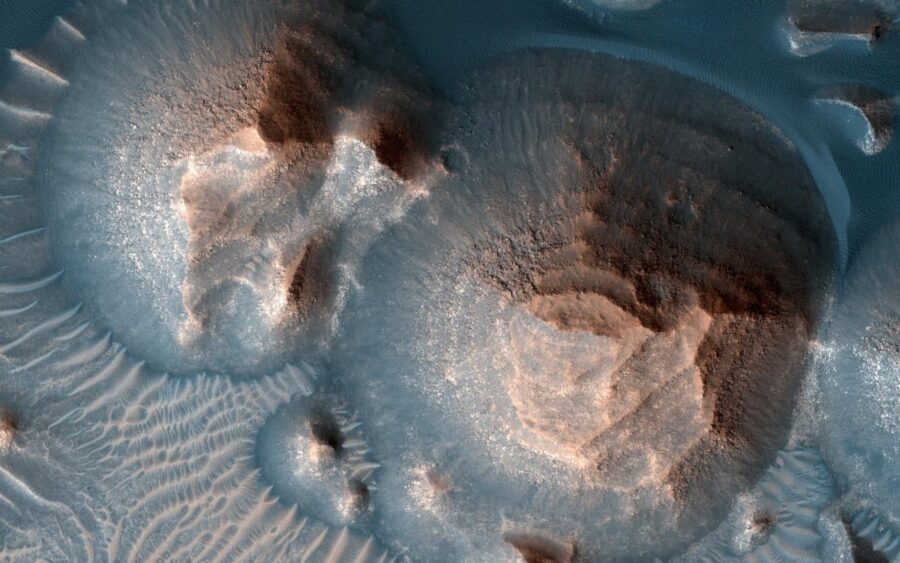Scientists have found massive ash deposits that formed over millions of years of volcanic super-eruptions, the first evidence for such explosive activity on Mars.

NASA / JPL-Caltech / University of Arizona
Explosive super volcanoes once tore apart the surface of Mars, spewing millions of tons of ash and noxious gases into the atmosphere.
Back then, Mars was volcanically active. It hosts the largest volcano in the solar system, Olympus Mons, and evidence of past vigor remains in volcanic regions and dormant cones. But evidence for explosive volcanism has been missing, leading some scientists to think that the planet only produced shield-type, cone-forming eruptions.
Now, a group of researchers has spotted massive deposits of volcanic ash buried in a region of Mars known as Arabia Terra. The researchers were scoping out the area because it hosts a series of irregularly shaped craters of unknown origin. A 2013 study suggested that these craters looked like calderas, the empty holes left behind by massive volcanic explosions.
These types of super-eruptions have occurred on Earth as well. The Toba (74,000 BCE) and Taupo (340,000 BCE) supervolcanoes are good examples. Evidence shows that these volcanos launched millions of tons of ash and gases into the atmosphere, enough to obscure sunlight for several years and cool the globe. If the same thing happened on Mars, proving it was a matter of finding the ash.
Arabia Terra is an area of rugged terrain, complex with high plateaus and sheer drops. Like road cuts, these ravines cut through the terrain, exposing the hidden layers on their walls. The team looked at the slopes of seven of these cliff faces from orbit using instruments on board NASA’s Mars Reconnaissance Orbiter and spotted layers of minerals with the composition of chemically altered volcanic ash.
The team also tapped into ash dispersion models to try to check if the thickness and distribution of the deposits matches what would be expected from an explosive eruption. “The models are actually pretty good for predicting what direction the wind blows,” says Patrick Whelley (University of Maryland, College Park), who led the new study. “The same models can be tuned [ . . . ] to use a slightly thicker atmosphere because maybe that's what was happening on Mars 3 billion years ago.”
With this method, the researchers confirmed that the ash deposits match predictions from the model, being thicker closer to the calderas, reaching one kilometer at its deepest point. They become thinner, although still hundreds of meters thick, farther away from the calderas. The paper describing their findings appeared online July 16th in Geophysical Research Letters.
“From the deposits that we do see from these types [of eruptions], they probably last for weeks to months at a time, where they're exploding and pushing out a bunch of material,” Whelley explains. “So it's not just one explosion but it's a series of sustained eruptions for many days up to months perhaps.”
In order to produce the massive ash deposits observed in Arabia Terra, researchers estimate that between 1,000 and 2,000 explosive eruptions occurred over a period of 500 million years. That means one supervolcano erupted every 1.8 to 3.5 million years. The volume of ash they produced accounts to about 30% to 60% of the total volume of material required to form Olympus Mons.
“Mars is a little planet compared to Earth, but it actually looks like early on its history, it was quite an active little planet,” says Alexandra Matiella Novak (Applied Physics Laboratory, Johns Hopkins University), coauthor of the new study. “At one point, Mars and Earth probably were very similar to each other climate-wise and atmosphere-wise, and certainly geology-wise.”
While other researchers think the current work is a step forward in the right direction, they aren’t fully convinced. “We still do not know for sure whether powerful volcanic eruptions took place in this region on early Mars,” says Petr Broz (Czech Academy of Sciences, Czech Republic), who wasn’t involved in the present study. “Erosion and younger resurfacing events could have destroyed or modified the evidence about such activity.”
Nevertheless, Broz adds, “This work is bringing us a bit closer to such an answer. It is showing us that a powerful and repetitive process has to be responsible for the formation of these enigmatic deposits.”
The team plans to continue looking for more spots where they can measure the thickness of the ash deposits, with the goal of building a more detailed regional map of the deposits’ distribution. “Now we have seven points, and we want to increase that to 100 points or something, so that we can we can say where the ash might have been,” Whelley says.
 0
0









Comments
You must be logged in to post a comment.